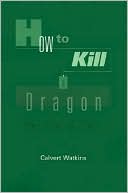

 |

|

The average rating for How to Kill a Dragon: Aspects of Indo-European Poetics based on 2 reviews is 3.5 stars.
Review # 1 was written on 2017-10-26 00:00:00 Clay Morton Clay MortonWhile 999 out of a thousand readers would find this book too difficult and obscure for words, I must say that it has been one of the most challenging and interesting non-fiction works I've ever had the privilege to study. I bought it and started reading it soon after it first came out, but around page 70 I felt I needed to stop and study some Hittite before continuing. Not to mention that I'd written down so many research questions at that point that it would take months to "catch up" with my outstanding questions. I got so much from those first 70 pages that I'd have given the book five stars based on that experience alone. Well, I explored Hittite (I could maybe order coffee in Hittite, except they didn't have coffee back then), I followed the research notes, and I learned many details of ring structure. And this year (yeah, I know, after two decades) I decided it was time to push on through the rest of the book. Did I comprehend it all? No, especially as my understanding of Classical Greek, Avestan, and Sanskrit is poor. But I could grasp the general outlines of the thing, which is sufficiently mindblowing. So, what the book does, is explore the existence and use of a formulaic construction in the early poetics of a number of Indo-European Language Group languages, to see if they are consistent enough to suggest that the formula dates back to Proto-Indo-European, and what it would have been in that language. The formula is, simply, HERO SLAY SERPENT, with the possibility of WITH A WEAPON or WITH A FRIEND but not both. What the book uncovers is that this formula persists across thousands of years, retaining not just the phrase but the same words (though shifting as the languages shift and break apart), and being used poetically in a surprising consistent series of poetic forms, usually framed with a ring structure to show its central importance, and with a number of poetic games played simultaneously at the same time. The formula appears not just in epic poetry, but also in prayers, charms, legal codes, and medical formulas. It is as though it's in our DNA. Along the way you discover just how clever folks like Pindar and Homer and the Vedic poets were, not to mention the Icelandic skalds and Old Irish bards. And you see, in the tradition and the practice, endless evidence of an Indo-European philosophical belief: that words have power, that words persist beyond death, that the right words can cure what ails us. The process of exploring this three-word phrase and its travels through history is unbelievably enlightening. The book is dense, and overwhelming, and difficult to describe. It's very, very technical, and the author expects you to go look up what you don't understand; but I never felt that he was using the technical language to impress. He just uses it to be clear and precise. If you have an interest in where our poetics came from, or an interest in the Indo-European language, you'll probably want to look into this volume at some point. If not, though, leave it alone. [It doesn't come until near the end, but the relationship between the terms DRAGON and WORM, in light of this formula, is wonderfully fraught. Talk about double meanings...] |
Review # 2 was written on 2020-07-10 00:00:00 Mellisa A Bailey Mellisa A BaileyOften engaging, never convincing. Watkins' premise is that it's possible to use the comparative method to reconstruct specific formulaic constructions, metrical styles, and other figures of poetic speech of Proto-Indo-European, and it's important not to let the book's mountain of (variably relevant, variably credible) philological trivia and more than occasional deliberate obscurantism hypnotise you into not noticing that this premise is false. The thing about the comparative method in linguistics isn't just that it lets us take two words in two related languages and let us reconstruct a common proto-form that we can automatically date to the time they were one language; it's that in reconstructing the proto-language it lets us construct a set of rules by which we can confidently distinguish true cognates from borrowings (and have a rough impression for when they were borrowed)'something that isn't possible even in principle when it comes to any aspect of poetics. Obviously when dealing with significant parallels in substantial bodies of work across relatively shallow time depths, it's usually possible to say something sensible about them, but Watkins spends more time spuriously projecting trivial two-word fragments (like the overexposed κλέος ἄφθιτον) across thousands of years, and when he does try to apply his method to something more significant'"the" titular dragon-slaying myth'the best he can do is to come up with hypergeneric formulas ("HERO SLAY ADVERSARY") which, for all their insipid vacuity, don't even fit the evidence properly and require endless variation. Did (to focus on a specific) the Proto-Indo-Europeans have a dragon-slaying myth? Probably; almost everyone did, Indo-European or not. Are literally any of the details recoverable using Watkins' methods? Clearly not. |
CAN'T FIND WHAT YOU'RE LOOKING FOR? CLICK HERE!!!